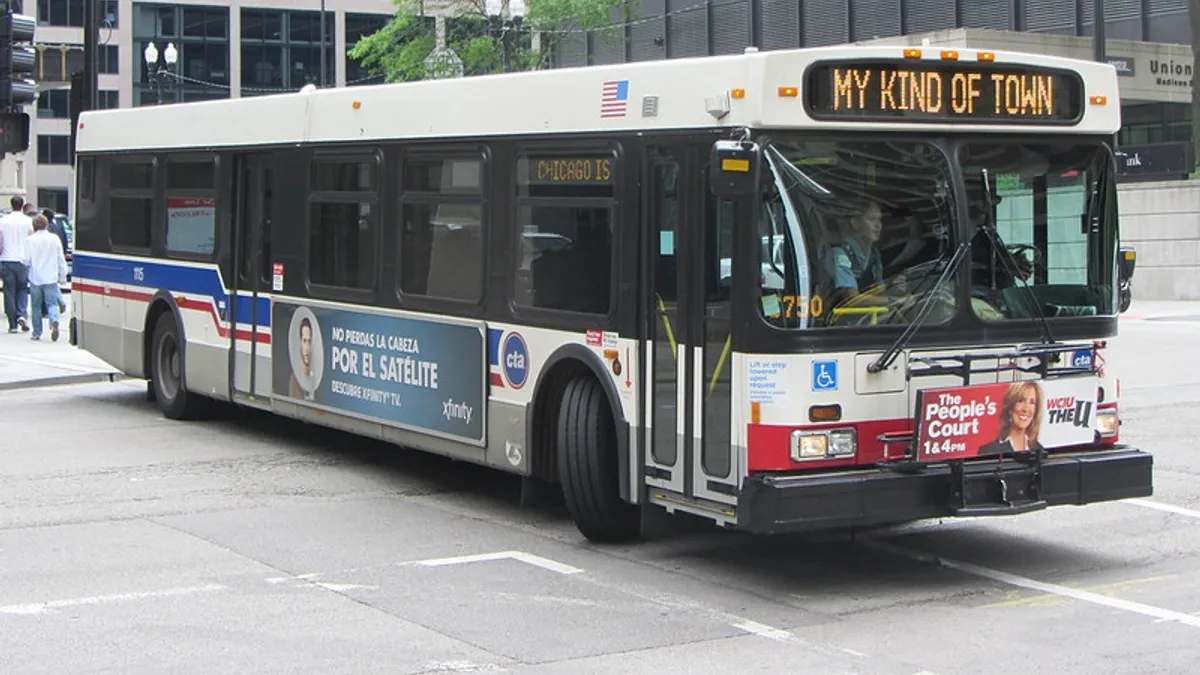Dive Brief:
- The Chicago Department of Transportation (CDOT) and the Chicago Transit Authority (CTA) announced a "pop-up essential bus lanes" program that will temporarily designate 24-hour bus-only lanes along two city routes to expand bus service for essential workers.
- The temporary lanes will be marked with striping and signs rather than the red paint the city uses for permanent bus priority lanes, said Mike Claffey, CDOT spokesman. The city intends to install the lanes within the next several weeks and run the pilot for at least six months to evaluate any changes with ridership and operations.
- "These lines have been busy throughout the pandemic, and we want to recognize that they carry essential workers who have to get to work. We want to make sure we're doing everything we can to make the service reliable and comfortable and safe," Claffey said.
Dive Insight:
While overall public transit ridership has taken a hit nationally amid a growing shift toward remote work, that's not necessarily the case for services that support a large number of essential workers, as seen along these two routes in Chicago.
And though there's been an increased emphasis on supporting essential workers' commutes since March, the city is implementing this program now to reduce bus service issues from traffic increases.
"We're seeing traffic slowly starting to build again, and we want to make sure we're maintaining reliable bus service. We encourage people to use the bus and we want them to feel comfortable and safe," Claffey said.
The city first announced planned improvements along these two bus corridors in 2018. Last year it provided $20 million in funding for CDOT and CTA to improve bus travel times and reliability along core routes as part of the Bus Priority Zone Program, and the two routes that will receive the new pop-up lanes received upgrades as part of the larger initiative.
Earlier this year, the Federal Highway Administration also approved the use of red paint to indicate bus priority lanes, and Chicago was one of the cities to test the use of this paint in a pilot program. Additional permanent bus priority zones are in the works and will be accompanied by street safety improvements for pedestrians.
The two pop-up essential bus lane routes also run partially through lower income neighborhoods, where residents are more likely to hold essential jobs and to take public transit to work, even with the risk of COVID-19 exposure and contraction. Industry data long has shown that low-income citizens exhibit higher rates of transit ridership, especially on the bus, because they have lower rates of car ownership or reliable access to cars.
Chicago and other cities have faced criticism for moving too slow in implementing COVID-19 protection plans for public transit riders. Transit agencies nationally have asked riders to practice social distancing on buses, but that's a difficult ask on many heavily traveled routes. In April, Chicago announced it would run longer and more frequent buses in certain neighborhoods to encourage social distancing. Chicago also joined other cities in implementing crowd management measures that prompted drivers to skip pick-ups if the bus is at COVID-era capacity.
The pop-up bus lane program aims to alleviate "bus bunching" in which two or more buses reach stops within seconds or minutes of each other because of schedule interruptions. Especially during the pandemic, this phenomenon can cause drivers to skip stops and leave riders stranded for long periods of time until the next bus arrives.
"In the context of COVID, this [initiative] makes trips quicker so people are not on buses as long and they do have room to space out," said Art Guzzetti, vice president of policy for the American Public Transportation Association (APTA). "Before this, a lot of transit systems [thought] the more people you can pack on a bus the better because you get a more productive trip. That rule has been thrown out. It's one of many changes that COVID brought."
The pandemic has provided an impetus for cities to accelerate discussions around redesigning and reworking streets to better accommodate changing needs, Guzzetti said. This week, for instance, Philadelphia announced the winning design for its repaving project that will rework the major thoroughfare Washington Avenue.
If Chicago's pop-up lanes are successful, the city may decide to make them permanent. Cities including Boston, New York and Washington, DC have seen success with dedicated bus lanes and more are considering this method, Guzzetti said. These projects often are referred to as "quick build" solutions because they don't require a lot of capital investments or time to implement, yet they provide significant value.
"Sometimes doing something quickly makes a lot of sense. It makes an urban community work better with just a few strategic decisions," Guzzetti said. "I think it's part of building back from COVID in a stronger and different way."













